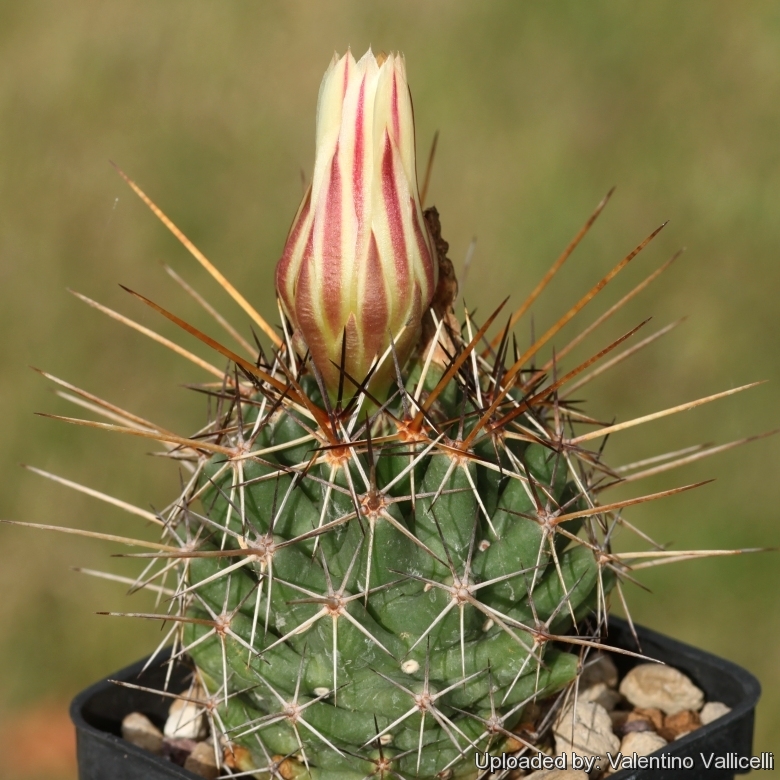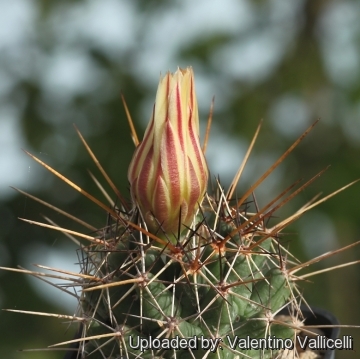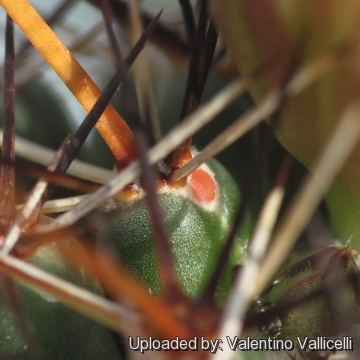




Your support is critical to our success.

Origin and Habitat: San Luis Potosi and nearby Guanajuato and Tamaulipas, Mexico.
Altitude: It grows at around 1600-2400 meters above sea level.
Habitat and Ecology: It grows together with Mammillaria erythrospermaSN|8929]]SN|8929]] in dry Oak forests on volcanic soils of plains and slopes and behind stony wall. The forest understorey is often grassy. The extent of occurrence is greater than 20,000 km², and although widely scattered with only a few plants are found in each locality where it occurs, this species occurs at more than ten locations and the population is not severely fragmented.
Synonyms:
- Coryphantha georgii Boed.
Coryphantha georgii Boed.
Monatsschr. Deutsch. Kakteen-Ges. 3: 163, fig. 1931
Synonymy: 3
- Coryphantha georgii Boed.
- Coryphantha grata L.Bremer
- Coryphantha villarensis Backeb.
Description: Coryphantha georgiiSN|10211]]SN|10210]] is a small rare species with pale creamy-yellow to pure white flowers.
Habit: Plants solitary.
Roots: Taproot.
Stem: Flattened globose to clavate, to 4 (or more) cm high and 7 cm in diameter, covered by spines, with woolly stem tips. Epidermis dark glossy green. The more clavate forms, which were described by Backeberg in 1942 as Coryphantha villarensisSN|10210]]SN|10211]], grow throughout the whole range of distribution, mainly in the shade, especially under bushes. Globular and clavate forms are only the result of the micro-location (more or less sun).
Tubercles: Loosely arranged in 5/8, 8/13 or 13/21 series, large, somewhat bulgy, conical, rounded and not keeled below, to 12 mm long, axils with wool and large orange-red nectar glands.
Central spines: 1-3(-4), rigid, to 20 mm long (or more) somewhat curved upward, grey or, especially in young plants, two coloured.
Radial spines: 8-9, needle-like, all the same length, greyish white with dark tips, to 12 mm long. Lower ones regularly and horizontally disposed, upper ones very close or bundled.
Youth form: Juvenile specimens have only 6 horizontally radiating radials, upper radials and central spines often with a sudden change of colour from brown to a chalky-white tip.
Flowers: Cream or white with pale green throats, 2-4 cm long and in diameter.
Bibliography: Major references and further lectures:
1) Edward Anderson “The Cactus family” Timber Press, Incorporated, 2001
2) James Cullen, Sabina G. Knees, H. Suzanne Cubey "The European Garden Flora Flowering Plants: A Manual for the Identification of Plants Cultivated in Europe, Both Out-of-Doors and Under Glass" Cambridge University Press, 11/Aug/2011
3) David R Hunt; Nigel P Taylor; Graham Charles; International Cactaceae Systematics Group. "The New Cactus Lexicon" dh books, 2006
4) Dr. med. Reto F. Dicht, Adrian D. Lüthy “Coryphantha: Cacti of Mexico and Southern USA” Springer, 2005
5) Friedrich Bödeker “Coryphantha Georgii Böd., spec. nova.” In: Monatsschrift der Deutschen Kakteen-Gesellschaft. Volume 3, pages 163–164 , 1931
6) Reto F. Dicht, Adrian D. Lüthy "A new conspectus of the genus Coryphantha." In: Cactaceae Systematics Initiatives. Number 11, 2001.
7) Dicht, R.F. & Lüthy, A.D. 2009. Coryphantha georgii. In: IUCN 2013. "IUCN Red List of Threatened Species." Version 2013.1. <www.iucnredlist.org>. Downloaded on 05 November 2013.
8) Urs Eggli, Leonard E. Newton Etymological Dictionary of Succulent Plant Names. Springer, Berlin/Heidelberg 2010

Coryphantha georgii Photo by: Valentino Vallicelli

Coryphantha georgii Photo by: Valentino Vallicelli
Cultivation and Propagation: In culture Coryphantha georgiiSN|10210]]SN|10210]] is without problems and regularly shows its large yellow flowers. It is a summer-growing species of easy cultivation but sensitive to overwatering (rot prone).
Growth rate: Slow growing. It needs about 8-12 years to reach the typical, definite outlook.
Soil: Grow it in an open sandy-gritty cactus compost.
Pots: It needs a relatively shallow pot to accommodate its fibrous roots and provide a very good drainage. They may stay in the same pot for many years.
Watering: Water in moderation, it prefer a completely dry place during winter. Mature individuals easily rot and die especially after planting so be extremely cautious with watering. Keep dry in winter or when night temperatures remain below 10° C. Water it less than average if in bigger pots.
Special need: Provide very good ventilation. Nearly all problems occur as a result of overwatering and poor ventilation, especially when weather conditions are dull and cool or very humid.
Fertilization: Feed them once during the growing season with a fertilizer specifically formulated for cactus and succulents (high potash fertilizer with a dilute low nitrogen), including all micro nutrients and trace elements diluted to ½ the strength recommended on the label. They thrive in poor soils and need a limited supplies of fertilizer to avoid the plants developing excess vegetation, which is easily attacked by fungal diseases.
Exposure: It will do its best with lots of sun and become stressed with inadequate light which could result in poor growth and unnatural shape.
Hardiness: It likes warmth (recommended minimum winter temperature 5° C) however plants kept perfectly dry can can survive low temperatures, approx. -5°, but for safe cultivation it is best to avoid freezing temperatures.
Use: It can be cultivated outdoors in raised beds, terraces if sheltered from winter rain.
Pests & diseases: These cacti may be attractive to a variety of insects, but plants in good condition should be nearly pest-free, particularly if they are grown in a mineral potting-mix, with good exposure and ventilation. Nonetheless, there are several pests to watch for:
- Red spiders: Red spiders may be effectively rubbed up by misting the plants from above.
- Mealy bugs: Mealy bugs occasionally develop aerial into the new growth and flowers with disfiguring results, but the worst types develop underground on the roots and are invisible except by their effects.
- Rot: Rot is only a minor problem if the plants are watered and “aired” correctly. If they are not, fungicides won't help all that much.
Propagation: Seeds. The seeds can be sown in pots of fine, well-drained sandy soil, any time during the spring when temperatures are warm. Cover the seeds with a fine layer of grit and water from below with a fungicide to prevent damping off. For the 1-2 weeks cover the pots with a sheet of glass/clear perspex to keep the humidity levels high. Remove the glass and replace it with light shade-cloth and mist once or twice a day for the next two weeks after which most seeds should have germinated. From then on mistings can be reduced to every second and then every third day as the little plants grow.
| Your Actions | |
|---|---|
| Back to Coryphantha index | |
| Back to Cactaceae index | |
 |
Back to Cacti Encyclopedia index |
Privacy stantement - Terms and conditions - How to cite - About us - Feedback - Donate




